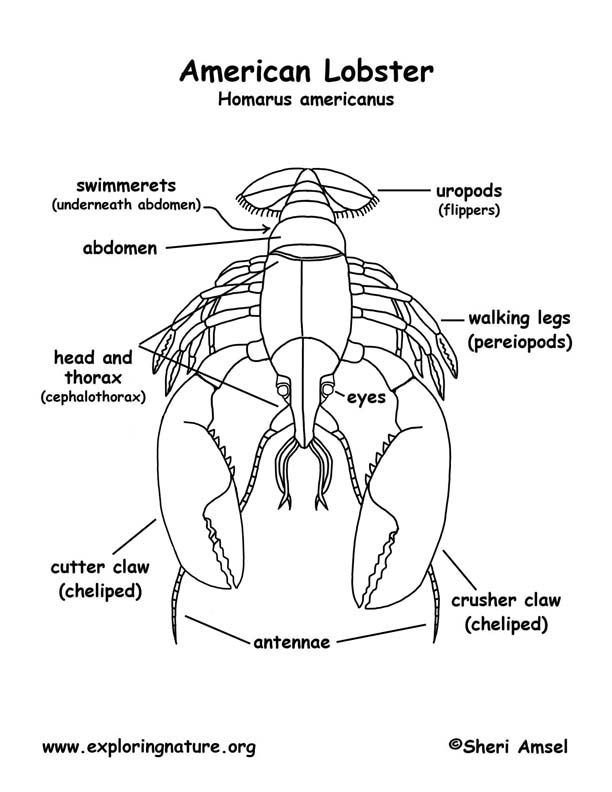

They are found on the Atlantic coast of North America from Newfoundland to North Carolina.
They live on the bottom of the ocean in rocky areas where they can find safe dens. Food filters down in the water and between the rocks and the lobsters will feed on it in addition to prey.
They have three pairs of antennas. One pair is long and segmented. The smaller pairs sit between them. They are used for touching as they move along on the ocean floor. The smaller antennas are sensitive to smells and help them locate prey. They have two light sensitive eyes at the base of the antennas. Their body is made up of a fused head and thorax (called the cephalothorax) with a pointed rostrum (nose) in front. Behind that is the abdomen (tail) that has 6 segments which allows it to bend. The fanned end of the abdomen is called the uropods. Their front legs are large claws called chelipeds. They are slightly different. One is larger with big teeth. This is called the crusher claw for breaking the shells of prey. The other is the cutter claw. The cutter claw is used to grab prey and tear out their flesh. Then they have four pairs of walking legs called pereiopods. The front walking legs do have small claws used when eating. Under the abdomen are 5 small pairs of fins called swimmerets (also called pleopods). They help them move along the ocean floor and females use them to move water over their eggs to give them oxygen.
They are territorial and can be aggressive and will fight one another for dominance. They hide in their burrow during the day and hunt on the ocean floor at night (nocturnal). As they grow they molt (shed their shell). They can molt more than 25 times in their first 5 years. This slows down to once a year as they age. After molting they have to hide for a couple of weeks until their new shell hardens to protect them from predators. They eat their old shell. If a lobster must escape a predator it will scoot backwards by pushing off while curling and uncurling its tail.
They eat other ocean invertebrates like crustaceans (crabs), mollusks (clams and mussels), worms, and sea urchins.
They are eaten when they are small by fish and other sea predators. As adults they are hunted by humans and wildlife that hunts on the shoreline, like raccoons.
Females mate after molting. Then after several months she lays her eggs into a sticky mass cupped in her tail. She carries the eggs for almost a year fanning them with oxygen and keeping them clean. When they finally hatch, she releases them into the ocean to make their way. Though she lays up to 20,000 eggs, most will be eaten by predators.
Kingdom: Animalia
Phylum: Arthropoda
Subphylum: Crustacea
Class: Malacostraca
Order: Decapoda
Infraorder: Astacidea
Family: Nephropidae
Genus: Homarus
Species: H. americanus
When you research information you must cite the reference. Citing for websites is different from citing from books, magazines and periodicals. The style of citing shown here is from the MLA Style Citations (Modern Language Association).
When citing a WEBSITE the general format is as follows.
Author Last Name, First Name(s). "Title: Subtitle of Part of Web Page, if appropriate." Title: Subtitle: Section of Page if appropriate. Sponsoring/Publishing Agency, If Given. Additional significant descriptive information. Date of Electronic Publication or other Date, such as Last Updated. Day Month Year of access < URL >.
Amsel, Sheri. "Lobster (American)" Exploring Nature Educational Resource ©2005-2024. December 13, 2024
< http://exploringnature.org/db/view/546 >

